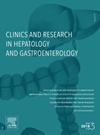Utility of the fibrosis-3 index for predicting liver fibrosis 5 years after achieving sustained virological response in patients with chronic hepatitis C
IF 2.4
4区 医学
Q2 GASTROENTEROLOGY & HEPATOLOGY
Clinics and research in hepatology and gastroenterology
Pub Date : 2025-05-27
DOI:10.1016/j.clinre.2025.102625
引用次数: 0
Abstract
Aim
Non-invasive tests for liver fibrosis frequently use serum aminotransferases; however, their accuracy may be influenced by hepatitis virus eradication. This study evaluated the effectiveness of the age-independent FIB-3 index in patients with chronic hepatitis C who achieved sustained virological response (SVR).
Methods
A total of 115 patients who achieved SVR following interferon therapy were analyzed. Liver fibrosis was assessed by biopsy before treatment and 5 years after achieving SVR. The diagnostic accuracies of the FIB-3 and FIB-4 indices were compared using Receiver Operating Characteristic (ROC) curve analysis and representative cutoff values (FIB-3:3.5, FIB-4:2.67), with a specific focus on age-stratified performance.
Results
Age-stratified analysis revealed distinct patterns in fibrosis index performance before and after SVR. Among patients aged ≥ 65 years, both indices demonstrated poor accuracy pre-SVR (FIB-3:0.35, FIB-4:0.29) but markedly improved post-SVR, with FIB-3 demonstrating significantly superior performance (accuracy: 0.82 vs 0.64). This improvement was primarily due to better specificity (FIB-3:0.85 vs FIB-4,0.60) while maintaining high sensitivity (0.62 vs 0.87). In patients aged < 65 years, both indices exhibited modest improvement post-SVR, with no significant differences observed.
Conclusions
At established cutoff values, the FIB-3 index demonstrated significantly higher diagnostic performance than the FIB-4 index, particularly in patients aged ≥ 65 years who achieved SVR. These findings suggest that the FIB-3 index is a reliable tool for long-term monitoring of liver fibrosis after hepatitis C eradication.

慢性丙型肝炎患者实现持续病毒学应答后5年纤维化-3指数预测肝纤维化的效用
目的:无创肝纤维化检查常用血清转氨酶检测;然而,其准确性可能受到肝炎病毒根除的影响。本研究评估了年龄无关的FIB-3指数在实现持续病毒学应答(SVR)的慢性丙型肝炎患者中的有效性。方法:对115例干扰素治疗后达到SVR的患者进行分析。治疗前和达到SVR后5年通过活检评估肝纤维化。采用受试者工作特征(ROC)曲线分析和代表性截止值(FIB-3:3.5, FIB-4:2.67)比较FIB-3和FIB-4指标的诊断准确性,并特别关注年龄分层的表现。结果:年龄分层分析显示SVR前后纤维化指数表现的不同模式。在年龄≥65岁的患者中,这两项指标在svr前的准确性较差(FIB-3:0.35, FIB-4:0.29),但在svr后的准确性显著提高,其中FIB-3表现出明显的优势(准确性:0.82 vs 0.64)。这种改善主要是由于更好的特异性(FIB-3:0.85 vs fib -4,0.60),同时保持高灵敏度(0.62 vs 0.87)。在年龄< 65岁的患者中,svr后两项指标均有适度改善,没有观察到显著差异。结论:在既定的临界值下,FIB-3指数的诊断性能明显高于FIB-4指数,特别是在年龄≥65岁且SVR达到的患者中。这些发现表明FIB-3指数是丙型肝炎根除后肝纤维化长期监测的可靠工具。
本文章由计算机程序翻译,如有差异,请以英文原文为准。
求助全文
约1分钟内获得全文
求助全文
来源期刊

Clinics and research in hepatology and gastroenterology
GASTROENTEROLOGY & HEPATOLOGY-
CiteScore
4.30
自引率
3.70%
发文量
198
审稿时长
42 days
期刊介绍:
Clinics and Research in Hepatology and Gastroenterology publishes high-quality original research papers in the field of hepatology and gastroenterology. The editors put the accent on rapid communication of new research and clinical developments and so called "hot topic" issues. Following a clear Editorial line, besides original articles and case reports, each issue features editorials, commentaries and reviews. The journal encourages research and discussion between all those involved in the specialty on an international level. All articles are peer reviewed by international experts, the articles in press are online and indexed in the international databases (Current Contents, Pubmed, Scopus, Science Direct).
Clinics and Research in Hepatology and Gastroenterology is a subscription journal (with optional open access), which allows you to publish your research without any cost to you (unless you proactively chose the open access option). Your article will be available to all researchers around the globe whose institution has a subscription to the journal.
 求助内容:
求助内容: 应助结果提醒方式:
应助结果提醒方式:


